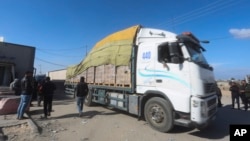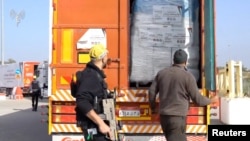The U.N. secretary-general renewed his appeal Monday for an immediate humanitarian cease-fire in the Gaza Strip, as the chiefs of his aid agencies called for more entry points for relief supplies to avert famine and the spread of disease.
“Nothing can justify the collective punishment of the Palestinian people,” Antonio Guterres told reporters at the United Nations. “The humanitarian situation in Gaza is beyond words. Nowhere and no one is safe.”
Guterres said he is “deeply troubled” by the “clear violations” of international humanitarian law.
“The long shadow of starvation is stalking the people of Gaza – along with disease, malnutrition and other health threats,” he said.
The United Nations’ aid agencies warned Monday that without additional access points into the Gaza Strip, the threat of famine and disease will grow among the already struggling population of 2.2 million people.
The heads of the World Food Program (WFP), the U.N. Children’s agency (UNICEF), and the World Health Organization (WHO), said in a joint statement that the opening of new entry routes, more trucks being allowed through border checks each day, fewer restrictions on the movement of humanitarian workers, and guarantees of safety for people accessing and distributing aid are needed for enough supplies to reach the Palestinians in Gaza.
“We cannot stand by and watch people starve. Humanitarian access is needed now for supplies to flow into and throughout Gaza and for civilians to safely receive life-saving aid,” WFP Executive Director Cindy McCain said.
McCain said famine can be kept at bay, but only if humanitarians can deliver sufficient relief supplies and have access to everyone in need, in all parts of Gaza. The WFP has reached more than 900,000 of the 2.2 million people in Gaza since the Israel-Hamas war started on October 7.
The U.N. and its aid partners have the use of the Rafah border crossing from Egypt into Gaza, which is primarily a pedestrian crossing, and cannot handle the volume of trucks that need to enter the territory, causing large backlogs.
Israel allowed the opening of the Kerem Shalom [Karem Abu Salem, in Arabic] crossing one month ago for humanitarians, but the U.N. says its use fluctuates depending on the security situation.
The aid chiefs say they need Israeli authorization to use a working port close to Gaza and border crossing points into the northern part of Gaza. They say access to Ashdod port, some 40 kilometers to the north, would facilitate significantly larger quantities of aid to be shipped in which they would then move by truck to northern Gaza. Despite Israeli evacuation orders, around 300,000 Palestinians remain in the north, and few convoys have been able to reach them.
“Since the start of the year, just seven of 29 missions to deliver aid to the north have been able to proceed,” Secretary-General Guterres said.
With only two border crossing options into Gaza currently, the WFP says it can only meet 20% of its monthly targets. On Saturday, the U.N. Office for the Coordination of Humanitarian Affairs said that 108 trucks with food, medicine and other supplies entered Gaza through the Rafah crossing. It did not report a figure for Kerem Shalom. Before the current escalation, around 500 commercial and aid trucks entered the enclave daily.
Israel put Hamas-controlled Gaza under a total blockade following Hamas’ terror attack in southern Israel on October 7, which killed some 1,200 people. The United States- and European Union-designated terror group also abducted around 240 Israeli and foreign hostages to Gaza. Just over a hundred were released during a weeklong pause in late November. Guterres repeated his call Monday for the immediate and unconditional release of the hostages.
The Hamas-run Gaza health ministry reports more than 24,000 Palestinians have been killed since October 7, most of them women and children.
Under intense international pressure, Israel has since eased its blockade, but Gaza remains without electricity and has experienced repeated telecommunications blackouts since October 7 — the latest one began on January 12.
Humanitarians say the inspection process for relief supplies remains slow and unpredictable, and Israeli authorities have restricted entry of some of the materials they urgently need, including generators.
Famine looms
The U.N.-backed Integrated Food Security and Nutrition Phase Classification warned last month that more than a half-million Palestinians in Gaza are coping with catastrophic levels of hunger, and nearly 400,000 are on the brink of famine.
UNICEF said Monday that Palestinian children are at high risk of dying from malnutrition and disease and urgently need medical treatment, clean water and sanitation services. But the conditions on the ground make it impossible for humanitarians to safely reach them, the agency says.
“Some of the material we desperately need to repair and increase water supply remain restricted from entering Gaza,” said UNICEF Executive Director Catherine Russell. “The lives of children and their families are hanging in the balance. Every minute counts.”
Hunger also puts people, especially children, at risk of dying from diseases, including watery diarrhea, which has climbed among children under the age of 5.
“Famine will make an already terrible situation catastrophic, because sick people are more likely to succumb to starvation, and starving people are more vulnerable to disease,” said WHO Director-General Tedros Adhanom Ghebreyesus.
“We need unimpeded, safe access to deliver aid and a humanitarian cease-fire to prevent further death and suffering,” he said.









